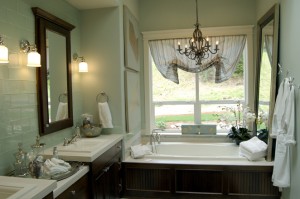Nothing epitomizes pure relaxation more than the serenity and ambiance of a spa setting. The smells and sounds alone are enough to immediately calm the body and soul. Unfortunately, enjoying these luxuries isn’t exactly a common occurrence. However, below are some great tips to help you modify your bathroom for a personal spa experience. Get ready to enjoy hours of escape and rejuvenation.
The Calm Color Palette
When selecting a color scheme, think nature, earthy and calming. Lighter color schemes provide a more airy, natural and relaxing feel. Neutral shades of light brown or beige offer an immediate connection to nature, and nothing says crisp or clean like bright white. Soft, pale shades of blue can also offer stress-reducing qualities due to their connection to the sea and sky.
Don’t Skimp on the Fixtures
If you want to genuinely create a spa-like bathroom, this is not a time to penny pinch. A luxury bathtub is a must. Consider a Jacuzzi or other spa tub adorned with wood or stone accents that enhance that connection to nature. Proper placement of your spa with unobstructed views to the outdoors is also recommended for increased relaxation.
Consider a custom-designed open shower constructed of textured tile or natural stone. Oversized, enclosed steam showers encased in glass are another great option.
Choose vanities for your spa bath that are open underneath for stacking your crisp, white towels neatly. Baskets can also be utilized to house rolled towels in an orderly fashion. Select stone or other natural elements for your countertops, and consider vessel sinks for a more nature-inspired, spa-like feel.
Lighting & Flooring Options
Invite as much natural light into your spa bath as possible and install fixtures that emit soft, calming light. Consider recessed lighting, and install dimmers on all fixtures to ensure complete control over mood and setting.
Select natural flooring options such as stone or tile. These materials invite nature inside and function well in a wet, humid environment.
Setting the Mood
Now that the basics are covered, create a tranquil setting by adding elements to relax the senses. Candles make a great addition to any spa setting as they emit a calming light and soft scents. Adding scented bath salts is another great way to enhance a relaxed state of mind.
Add music to your spa bath. Soothing sounds such as rolling waves or a light drizzle in the rainforest also are great, peaceful options.
Keep décor to a minimum as too much clutter can create a distracting feel. Houseplants seem to be a spa favorite as they add nature and help create a healthy environment.
There are many elements to explore when creating a spa zone in your home. Before you begin, be sure to contemplate what is most calming to you. Take whatever design elements you want and leave the rest, along with the stress from the day, at the door.
*Image found in Google images*
For more information, please contact me at 703-340-7096 or email at sheilad@homes4saleinDC.com






